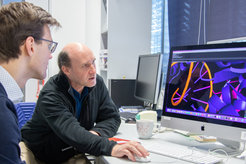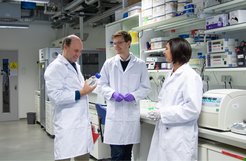Structural Biology of Selfish RNA
Oliver Weichenrieder
LINE-1 and Alu RNAs can be regarded as ‘selfish’ RNAs that propagate in their human ‘hosts’ in the form of non-LTR retrotransposons. Non-LTR retrotransposons belong to the simplest forms of selfish RNA. These RNAs have no viral relatives and integrate into the genomes of their hosts by target-primed reverse transcription, which occurs directly on genomic DNA and is fundamentally distinct from the cytoplasmic processes mediated by the long terminal repeats of LTR retrotransposons and retroviruses. We are interested in the molecular details that govern this integration process and combine mechanistic analyses based on molecular structures with cell-based retrotransposition assays.

LINE-1 RNA encodes two proteins (L1ORF1p and L1ORF2p) that are essential for its propagation, whereas Alu RNA has evolved as a ‘parasite’ of LINE-1 RNA, which ‘hijacks’ the L1ORF2p reverse transcriptase for its own propagation. Over time, LINE-1 and Alu RNAs have retro-copied themselves into more than 1.5 million genomic locations with consequences for human evolution and disease that are just beginning to unravel.
Our current projects aim to shed light on
(i) the structure and function of the L1ORF1 protein in LINE-1 retrotransposition
(ii) the mechanism of target-primed reverse transcription by L1ORF2p
(iii) the structural features of Alu RNA required to exploit the LINE-1 retrotransposition machinery
In the long run, we aim at a more general picture of the ‘molecular ecology’ of selfish RNAs and of their molecular interactions with the respective hosts, as these continue to drive evolutionary innovation in many areas of biology.




